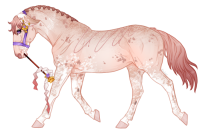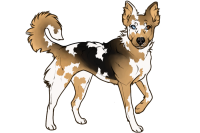
The National Range Trotters Association (NRTrA) formally began in 2015, by a man named Jackson Devin. Prior to his forming the association, his great grandparents owned a rather bustling ranch in western Europe, but immigrated to the United States in the 1930's. Though they sold many of their horses, they brought with them one Hanoverian mare, two Orlov trotter mares, a large Welsh Cob mare and a Finnhorse stallion.
After settling into their new home in the midwestern United States, they eventually imported two other horses; a large Hanoverian stallion and a Welsh Cob mare. These seven horses began their line of all-around work horses, eventually becoming the first Range Trotters, and they were well known in the area for their eagerness to please and do all sorts of work, as well as their athleticism when being used as jumpers in the show ring. Jackson's grandparents continued the line, but their children moved into other areas of interest in their lives and Range Trotters had a stagnant period for some time. Jackson began breeding them once more in 1999 at the age of eighteen, various interviews with the man stating that he fondly remembered these horses from time spent with his grandparents. The introduction of Quarter Horses, Paint and Appaloosa horses is quite recent, but has only added to the breeds hardiness and versatility.
These are the tiers you can achieve in each discipline, from lowest to highest.


•
V1 Trotters may not be entered!• Each horse may only be entered into
one show per run.
• Only
three trotters may be entered per show type at this time.
• All Trotters must be named, have a halter and be listed in the up-to-date stable.
• Horses must have the correct corresponding reference image
or item usage posted by staff on their adopt page.
• From show level 4 (Elementary, Class I) onward, Trotters should have a mane- and tail-dye free reference.
• Entries that do not meet the proper reference requirements will be skipped.

Trotters will be promoted in rank depending on how they place in the competition.
These placements are
randomized.
First place will always move
forward a tier, but both
second and third placings have a
50% chance to either progress or fail.
Horses that do not place among the top three are not directly mentioned in the results and do not have the chance to raise their rank that particular round, but are free to try again in as many rounds as they would like.
If there are less than three owned entrants, the rest of the list will be filled with NPCs (non-existing horses) as placeholders and they will be rolled as if they were real competitors.
In addition to promotions, first-, second, and third-place winners will be rolled for
bonus items.
First placements will roll for a
Twin Booster,
Fly Mask or
Body Brush.
Second placements will roll for a
Dandy Brush or
Dye Kit.
Third placements will roll for a
Curry Comb or
Silk Ribbon.
All bonus items will be rolled as follows:
1-7 - no item
8-10 - bonus item

Trotters will become champions if they
place first in the final show level (Grand Prix, Gold Division) of the entered discipline.
A horse may champion in each discipline, all giving boosts per championship.
There must be
at least three owned entrants (so no NPCs) in the competition group in order to become a champion.
When a horse becomes a champion, HowlingHooves will post on their adoption page stating the following;
This trotter is a Champion "competition here" horse!
They will receive the following benefits:
• +1 Breeding Slot
• +3% to Twin Rate
A single horse can achive
four total championships at this time, amounting to
+4 breeding slots and
+12% twin boost.
There is also a special shop for champions in the works!






















